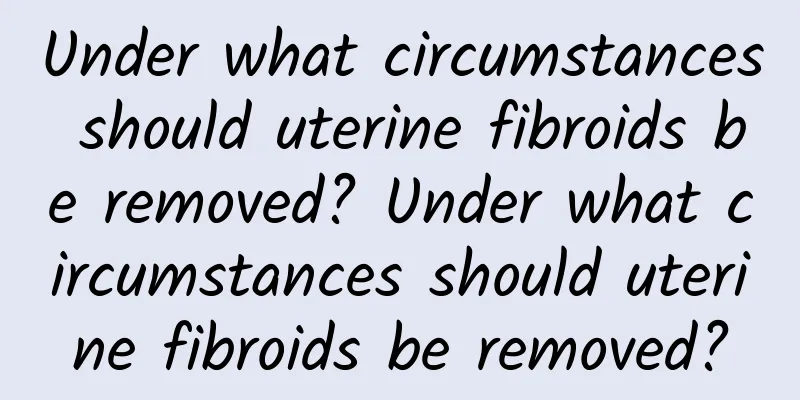Under what circumstances should uterine fibroids be removed? Under what circumstances should uterine fibroids be removed?

|
Under what circumstances should uterine fibroids be removed? Under what circumstances should uterine fibroids be removed? Uterine fibroids are common benign tumors in women, especially in women of reproductive age. They are tumors caused by uterine smooth muscle cell diseases, usually growing in the uterine wall, sometimes in the uterine cavity or on the surface of the uterus. Although most uterine fibroids are small and asymptomatic, in some cases, uterine fibroid removal is necessary. For patients who have obvious symptoms, it is necessary to remove the uterine fibroids. Some common symptoms include irregular menstruation, excessive menstruation, blood clots in menstrual blood, abdominal pain, pelvic pressure, etc. These symptoms will affect the patient's quality of life, and if not treated in time, they may lead to complications such as anemia and pelvic inflammation. Therefore, it is necessary to remove the uterine fibroids when these obvious symptoms appear. For patients with large or rapidly growing uterine fibroids, uterine fibroid removal is also necessary. Although most uterine fibroids grow slowly, some tumors grow rapidly. In this case, the uterine fibroids may reach a large size, which increases the difficulty of surgery, and benign tumors may also cause compression on surrounding organs, causing various discomforts. Therefore, for large or rapidly growing uterine fibroids, especially when they have affected the function of surrounding organs, uterine fibroid removal is necessary. Uterine fibroid removal can also be considered for patients in some special circumstances. For example, for young women, since the presence of uterine fibroids may affect fertility, it is necessary to remove the uterine fibroids. In addition, for postmenopausal women, since the presence of uterine fibroids no longer has fertility, and the enlargement of the tumor may cause more complications, uterine fibroid removal can also be considered. Removal of uterine fibroids is not suitable for all patients. The doctor will make a comprehensive assessment based on the patient's specific situation, including the size of the tumor, the growth rate, the severity of the symptoms, and the patient's own needs, and ultimately decide whether to remove the uterine fibroids. Therefore, after the patient finds that he has uterine fibroids, he should seek medical attention for a detailed examination and take appropriate measures according to the doctor's advice. When to remove uterine fibroids is a complex issue that requires comprehensive consideration of many factors. For some patients with obvious symptoms, large or rapidly growing uterine fibroids, and patients in special circumstances, uterine fibroid removal is necessary. Only through the doctor's careful evaluation and the patient's own decision can the most suitable treatment plan be found to maximize the treatment effect. |
<<: What is considered malignant uterine fibroids? Is malignant uterine fibroids uterine cancer?
>>: What is considered malignant uterine fibroids? Does malignant uterine fibroids mean cancer?
Recommend
What is the route of infection of pelvic inflammatory disease?
Pelvic inflammatory disease is usually a mixed in...
What are the routine examination items for cervical precancerous lesions?
Cervical precancerous lesions are a common diseas...
What's wrong with dysmenorrhea, chills and vomiting?
What’s wrong with dysmenorrhea, chills and vomiti...
How to prevent cervical warts
To prevent cervical warts, we must talk about the...
High fiber for weight loss without harming your body! Three Chinese herbs must be added to fruit and vegetable juices
What should you do if you want to lose weight but...
What to do if your period is delayed
Delayed menstruation is a common type of menstrua...
What are the symptoms of uterine fibroids? What are the types of uterine fibroids?
We must actively grasp the symptoms of uterine fi...
Women should pay special attention to the causes of ectopic pregnancy
In recent years, many women may suffer from ectop...
Can uterine effusion be treated with Chinese herbal medicine?
Clinically, most women's uterine effusion is ...
How to perform surgery for ectopic pregnancy
Ectopic pregnancy is a type of ectopic pregnancy....
Do women with mild cervical erosion need treatment? Women with mild cervical erosion may not need treatment
Cervical erosion is actually a misunderstanding o...
What are the effects of pelvic inflammatory disease?
The incidence of pelvic inflammatory disease is r...
Abnormal yellow leucorrhea with odor and itching
Abnormally yellow leucorrhea, odor, and itching m...
Attention should be paid to daily care of patients after abortion
After abortion, the patient is weak and has low r...
How to treat 1st degree cervical erosion
How to treat first-degree cervical erosion? I bel...









